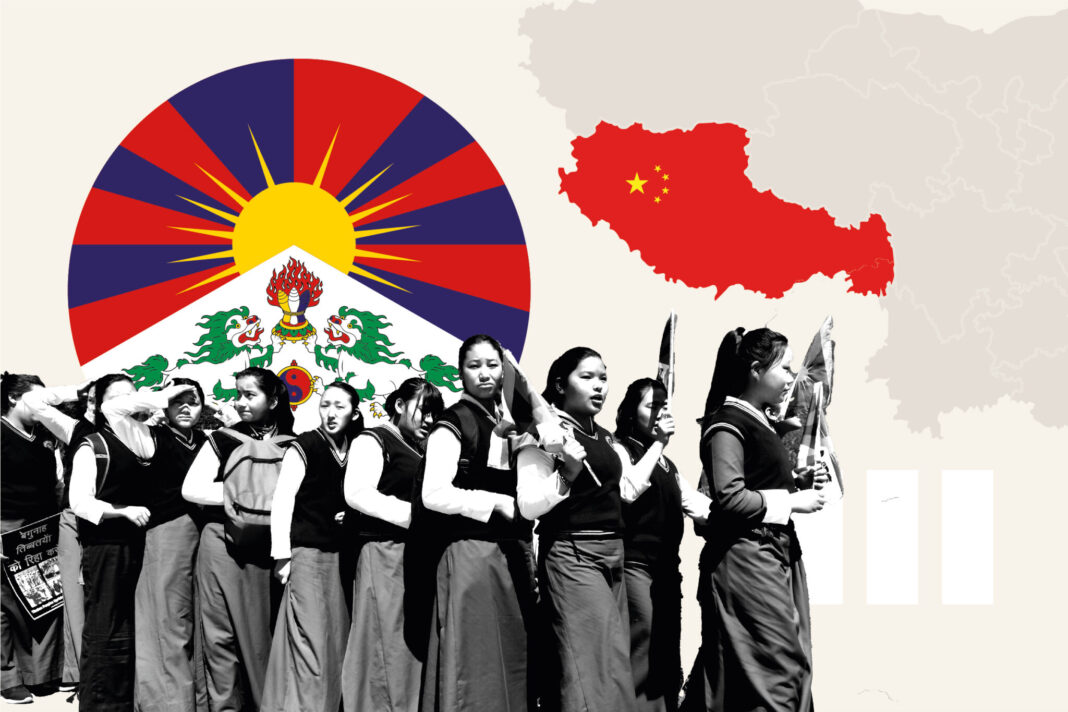When Chinese troops advanced into Tibet on October 7, 1950, most Tibetans were unaware of the invasion. Dawa Norbu, a toddler at the time, wrote in 1978 for Worldview magazine: “The news about the Chinese invasion of 1950 reached us sometime in 1952.”
Such was Tibet in 1950. On the “roof of the world”, a remote land far removed from both the boons and banes of modernity, news travelled slowly, and concern even slower. “Despite the alarming news, no one in Sakya sharpened his sword or dusted his bow and arrows,” Norbu wrote.
Residents of Sakya would not have imagined that the Chinese invasion would effectively begin a permanent occupation that would change Tibet forever. Seventy three years after the invasion, we recall how it unfolded.
China’s motivations for capturing Tibet
Even before the proclamation of the People’s Republic of China on October 1, 1949, the Chinese Communist Party (CCP) had made it a top priority to annex Tibet. There were both ideological and pragmatic motivations behind this.

The communists wanted to shore up China’s southwestern border and access Tibet’s plentiful natural resources. Ideologically, for the CCP, Tibet was a feudal-theocracy whose people needed “liberation”. Also, Tibet’s annexation was seen as the culmination of a historical project — Tibet had always been a part of China, and for the newly assertive Chinese state, Tibet’s incorporation was simply fulfilling the call of destiny.https://www.youtube.com/embed/cBQ0O4THACo?version=3&rel=1&showsearch=0&showinfo=1&iv_load_policy=1&fs=1&hl=en-US&autohide=2&wmode=transparent
But Tibet’s history was different. Prior to 1950, Tibet had historically existed independently of Chinese control, with its own unique culture, language, and religion. Even after 1720, when the Qing dynasty established its suzerainty over Tibet, Tibetans remained largely free of any direct Chinese interference in their affaires. And after the end of Qing rule in 1911, Tibet became a de-facto independent state.
How the communists’ invasion progressed
Tense negotiations were underway between Lhasa and Beijing for much of 1949-50. China had a three-point proposal: 1) that Tibet be regarded as part of China, 2) that China be responsible for Tibet’s defence, and 3) that China be responsible for Tibet’s trade and foreign relations.
Simultaneously, the Peoples’ Liberation Army (PLA) steadily built up forces at Tibet’s eastern border. The idea was to force Tibet’s hand in negotiations. Tibet had a small, ill-equipped army, which was no match to the might of the PLA. Its borders were porous, and the population relatively small and spread out. In case of an invasion, Tibet did not stand a chance without foreign support — and none seemed to be coming its way.
The PLA crossed the Jinsha (Yangtze) river and entered the province of Kham in the early hours of October 7, 1950. By October 19, it had captured the town of Chamdo, and neutralised the Tibetan garrison there. Over 3,000 Tibetans were made prisoner, and at least 180 died in the fighting (although some sources put casualties at over 3,000).
China stopped hostilities soon after — the point had been made. It sent the defeated governor of Chamdo, Ngabo Ngawang Jigme, to Lhasa to reiterate its proposal to the Dalai Lama, who was then only 15 years old.
Tibet was forced into subjugation by the Chinese
In May 1951, under a great deal of duress, Tibetan plenipotentiaries signed what is commonly referred to as the The Seventeen Point Agreement. The agreement effectively subordinated Tibet to China, allowed the PLA to take position within the country, handed over all international affairs to Beijing’s control, and allowed China to “reform” the economy.
However, it also assured non-interference in domestic administration, Tibetan culture, and religion. “The Tibetan people have the rights to exercise national regional autonomy under the unified leadership of the Central People’s Government,” point 3 of the agreement stated.
But even before the ink on the treaty dried, the Chinese began violating it. With the PLA a threatening presence across Tibet, Chinese interference in Tibet grew. Bit by bit, it ate away at the Tibetan administration’s autonomy and soon, large-scale communist “reforms” were introduced in Kham and Amdo.
National uprising and the Dalai Lama’s exile
By 1954, resistance in Tibet was growing, as the Chinese began destroying monasteries and imposing collectivisation. There was interference in all aspects of Tibetan life, from schooling to cultural beliefs. There also emerged a steady stream of refugees into Lhasa and central Tibet, especially from the eastern regions where the effects of the reforms were felt the hardest.
Growing frustration among the Tibetan population came to a head in March 1959 when a revolt erupted, first in Lhasa. Amidst fears that the CCP might arrest the Dalai Lama, protesters thronged Lhasa’s streets and clashed with the PLA.
Chinese reprisals were brutal. Some assessments put the number of Tibetans who were killed at more than 80,000. The PLA shelled Lhasa incessantly, reducing many of its beautiful monasteries to rubble.

On March 23, the Dalai Lama fled Lhasa, never to return, as the city was taken by the Chinese. Even as he was being taken to India (Tawang, in present-day Arunachal), the young Dalai Lama repudiated the Seventeen Point Agreement and proclaimed himself as Tibet’s sole legitimate representative.
Since 1959, China’s hold over Tibet has been absolute. It has crushed dissent, installed its own people in religious positions, and facilitated an influx of Han Chinese immigrants into Tibet, changing both its demographic and cultural makeup.

